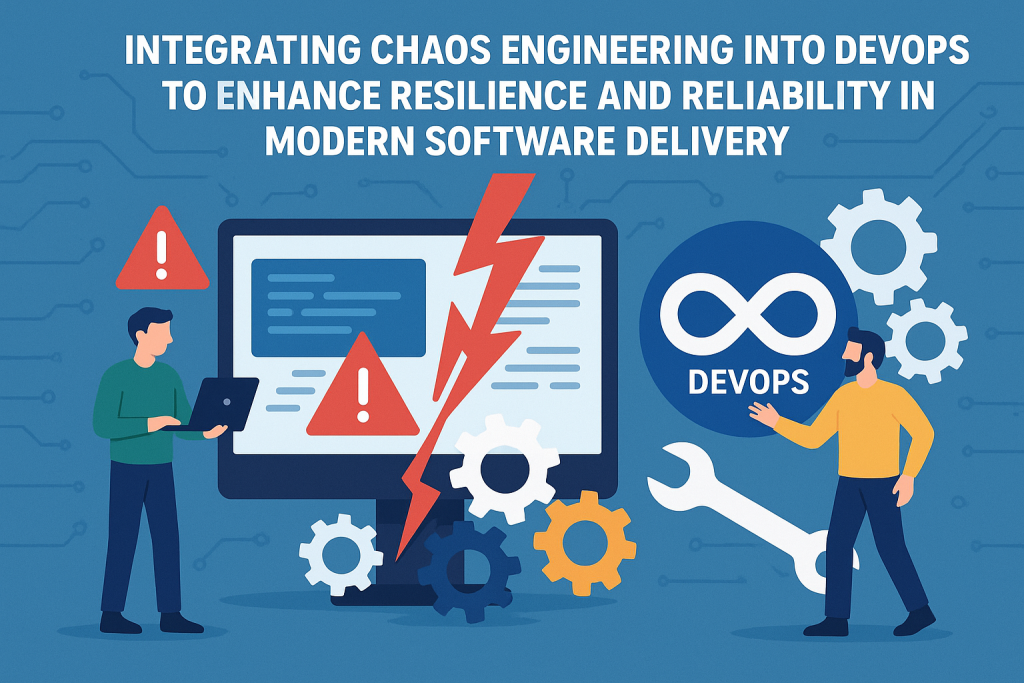Chaos engineering is particularly relevant in DevOps, as it aligns with the DevOps principles of continuous improvement, automation, and resilience in software delivery. Here’s how chaos engineering applies in the DevOps world:
1. Continuous Testing and Validation of Resilience
In DevOps, continuous integration (CI) and continuous delivery (CD) pipelines ensure that changes are consistently integrated, tested, and deployed with minimal downtime. Chaos engineering extends this concept by adding continuous testing of system resilience.
For example, incorporating chaos experiments in CI/CD pipelines enables teams to automatically simulate failures in pre-production or production environments, ensuring each deployment can handle disruptions.
2. Enhanced Monitoring and Observability
Chaos engineering experiments highlight the importance of monitoring and observability, which are key aspects of a DevOps workflow. By intentionally disrupting services, teams can identify gaps in their monitoring systems and fine-tune alerting mechanisms.
3. Shift-Left Approach to Reliability
DevOps has a strong focus on shifting left—meaning issues should be detected and addressed as early as possible in the development cycle. Chaos Engineering applies this approach by testing system resilience early in development, preventing weaknesses from making it to production.
4. Automation in Resilience Testing
DevOps emphasizes automation to reduce manual work, streamline workflows, and minimize human error. Chaos engineering tools can be automated to simulate outages, network failures, and resource constraints at specified intervals or as part of deployment pipelines.
5. Improved Incident Response and Recovery
DevOps teams are often responsible for the “you build it, you run it” philosophy, meaning they need to be well-prepared to handle incidents. Chaos engineering helps these teams practice incident response under controlled conditions.
6. Collaboration and Culture of Resilience
One of the key goals of DevOps is to foster collaboration between development and operations teams. Chaos Engineering supports this by creating a shared responsibility for system resilience.
7. Scaling Infrastructure with Confidence
DevOps teams often manage scalable infrastructure, especially in cloud environments. Chaos engineering allows them to test the system’s ability to handle scaling under stress.
8. Security Resilience
With the growing focus on DevSecOps, integrating security into the DevOps lifecycle is crucial. Chaos engineering can also be applied to test security resilience by simulating scenarios like compromised nodes.
Practical Applications in DevOps Environments
Load Testing in Pipelines
Automated chaos experiments can introduce varying load levels on services in pre-production environments, ensuring that services don’t degrade when deployed under high load in production.
Network Disruptions
DevOps teams managing microservices can simulate network latency or connection issues to see how individual services cope.
Server Outages
Chaos tools like Chaos Monkey can randomly shut down instances in cloud environments to test if load balancers and failover mechanisms work as intended.
Dependency Failures
In a microservices architecture, chaos engineering can simulate failures of specific service dependencies to verify that the system can degrade gracefully.
Tools for Implementing Chaos Engineering in DevOps
- Gremlin: Provides APIs and tools to automate chaos experiments in various environments, including Kubernetes, cloud, and on-premises.
- Chaos Mesh: Built for Kubernetes environments, allowing teams to perform chaos experiments on containerized applications within their DevOps pipelines.
- AWS Fault Injection Simulator: An AWS-native tool that integrates with AWS environments, allowing teams to conduct fault injections on their cloud infrastructure.
- LitmusChaos: An open-source tool for chaos testing in Kubernetes environments, allowing automated resilience testing in CI/CD pipelines.
Challenges of Implementing Chaos Engineering in DevOps
Balancing Experimentation and Stability
In a fast-paced DevOps environment, too many chaotic experiments in production could destabilize systems. It’s crucial to plan experiments carefully and balance risk with stability.
Skills and Knowledge Gap
Chaos engineering requires specific skills in resilience testing, monitoring, and analysis, which may not be common in every DevOps team.
Resistance to Experimentation
Teams might resist chaos engineering because it seems counterintuitive to introduce failure. However, fostering a culture of resilience and explaining the benefits can help overcome this barrier.
Conclusion
Chaos engineering aligns closely with DevOps principles of resilience, automation, and continuous improvement. By intentionally introducing controlled failures, chaos engineering empowers DevOps teams to build more robust systems, improve incident response, and foster a culture of resilience. As chaos engineering becomes more integrated into DevOps, it will continue to play a vital role in making distributed systems more reliable, scalable, and prepared for real-world challenges.



